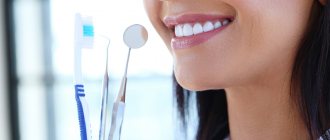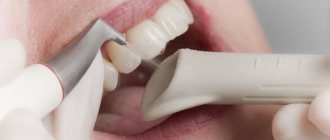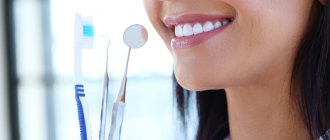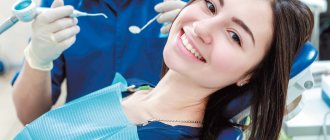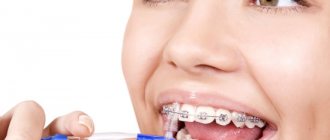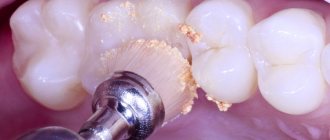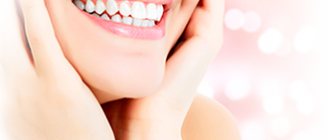Professional hygienic cleaning of teeth and oral cavity at the dentist - what is it, how is such a procedure carried out? Doctors recommend using this method once every six months. During one visit to the dental office, a whole range of measures is carried out: plaque and hard deposits (stone) are removed, inflammatory diseases are prevented, and the general condition of the dentition is improved.
Currently, there are several methods of cleansing, which include laser, ultrasound, and the modern “Air Flow” technique. Carrying out a hygienic procedure in dentistry has many advantages and is popular among patients.
Differences between professional teeth cleaning and daily cleaning
In addition to daily morning and evening sessions with a brush and paste, other manipulations should be performed to help maintain the health of the mucous membranes and prevent the formation of plaque and tartar. Dentists advise periodically seeking professional help, because usual care at home does not provide one hundred percent protection against deposits.
Hard-to-reach places (interdental spaces, the inside of the chewing units on both jaws) are difficult to clean. As a result, an environment favorable for pathogenic microorganisms is formed in hidden areas, and pathogenic bacteria begin to actively multiply.
The process of mineralization of the soft bacterial layer is not noticeable to the naked eye. Because of this, the patient may not even realize for several months that he has tartar.
If you do not consult a doctor promptly, hardened deposits can cause serious complications. Caries, periodontitis, gingivitis and other pathological processes develop.
How do you know if you need to have your teeth cleaned at the dentist? Is it worth spending time and money visiting the clinic? Cases when this is necessary:
- subgingival or supragingival stone has formed;
- food particles have accumulated on surfaces and formed a dense whitish layer;
- the mouth smells unpleasant;
- gums bleed, pain is present;
- for preventive purposes to prevent periodontal disease and gingivitis.
Cleaning methods at the dentist
Professional hygienists and periodontists use a whole arsenal of methods for cleaning teeth. This can be the simplest influence (instrumental) or more advanced (Air Flo, ultrasonic, etc.). Which option to choose depends on the following factors:
- the patient’s health status, his well-being;
- thickness, structure, density of plaque or stone;
- age (some activities are contraindicated for children);
- location of formations;
- financial opportunities.
It is also possible to use several techniques for complex effects. In this way, you can speed up the onset of a positive result and prolong the effect for up to six months or more.
Mechanical (manual)
One of the oldest methods, which does not lose popularity due to its affordable price. The use of expensive equipment is not required here; the doctor uses special tools with hooks to remove hard deposits.
The procedure has a significant drawback. As a result of mechanical impact, the enamel may be damaged. It cannot be performed if a person has hypersensitivity. In some situations, this option is the only acceptable option if there are contraindications.
Using the Air Flow system
What is included in professional teeth cleaning with Air Flo: the teeth are treated with a mixture of water, abrasive particles and air. All this is supplied under a certain pressure. The layer is easily removed without causing any discomfort to the patient, and the structure of the units is not affected. The enamel becomes several shades lighter. Unfortunately, such a delicate method cannot get rid of old deposits.
Ultrasonic
Ultrasound crushes the hardened layers, and their particles are then washed out with water. This way you can remove plaque and stone not only from visible surfaces, but also from hard-to-reach places (for example, in the spaces between teeth). If the accumulated layer was too hard and old, discomfort may be present for several days.
Laser
The laser beam removes old deposits. The person does not experience pain or other discomfort; the incisors, canines and molars remain intact. The condition of soft tissues improves. In addition, the method helps disinfect the oral cavity. The procedure will cost more than other types of cleansing.
Polishing
In this way, the dentist eliminates unevenness and microcracks on surfaces that formed after applying the above methods. If you skip this step, the enamel will be rough and food particles will be trapped on it. As a result, plaque will very quickly accumulate again, harden and turn into stone.
How is hygienic teeth cleaning done, are special tools needed? Hard fabrics are polished using special devices alternating different types of attachments, such as:
- needle-shaped (for grinding);
- brushes (clean out leftover food);
- polishers (process crowns and dentures);
- discs (give perfect smoothness and shine);
- strips (for interdental spaces).
Fluoridation
This is an optional procedure, but it is still worth agreeing to it. It helps overcome sensitivity, strengthen enamel, and prevent the appearance of carious lesions. Surfaces are treated with special substances – fluorides.
Pros:
- the level of fluoride in the body is normalized;
- the strength of dental units increases;
- the leaching of calcium, which affects vital processes in the skeletal system, is stopped;
- the growth and reproduction of pathogenic microorganisms slows down.
What does the doctor do:
- drying is performed with a jet of air;
- a solution enriched with active ingredients is applied with a brush or using trays;
- recommendations for prevention are given.
Fluoridation is the final stage of purification in a clinical setting.
What is gum curettage and why is it needed?
Lack of high-quality daily hygiene contributes to the accumulation of soft plaque and hard tartar on the teeth. When a large amount of deposits forms, they gradually descend under the gums. This leads to peeling of the mucous membrane from the tooth and the formation of periodontal pockets. During eating, food gets clogged up in them and cannot be removed on its own. This creates favorable conditions for the development of a focus of infection that affects and destroys periodontal tissues. The apogee of the pathological process is the loosening and loss of teeth. It is extremely important not to bring the situation to a critical point and remove plaque in a timely manner.
Gum curettage or SRP (Scaling and Root Planing) is a deep cleansing of periodontal pockets from plaque accumulations , which is the main cause of the inflammatory process of periodontal tissues. It is carried out using special instruments (curette).
Deep cleaning of periodontal pockets using curettes
The procedure also involves polishing the roots of the teeth - cleaning from the remains of plaque, plaques and granulations. After removing deposits, the roots of the teeth become rough, and this contributes to the rapid accumulation of new plaque. To avoid recurrence of inflammation, they are treated and polished.
Gum curettage
is a tooth-preserving procedure
. Unlike classical oral hygiene, this is a deeper cleansing of not only the tops of the teeth, but also their roots. Allows you to get rid of the source of infection, eliminate the deep inflammatory process in periodontal tissues, thereby improving dentogingival attachment and preserving teeth.
Levin Dmitry Valerievich Chief physician and founder of the Doctor Levin center
Caring for your teeth after professional cleaning
Based on the results of the procedure, the doctor should give recommendations on proper hygiene. Basic Rules:
- For several days after medical procedures, it is important to clean the teeth not only twice a day, morning and evening, but also after each meal. If this is not possible, it is enough to rinse your mouth with clean water or a special mouthwash.
- The paste and brush should be carefully selected depending on the patient's needs. If in doubt, consult your dentist.
- You need to stop eating hot and cold for a while. This is due to increased sensitivity after external exposure.
- You must completely abstain from smoking for at least 3 days. This way the natural whiteness of the enamel will remain for a long time.
- It is advisable to exclude coloring foods and drinks (tea, coffee, chocolate) from the menu.
- You can’t eat too sour and sugary foods, or chew nuts or candy.
- If the process has been completed with fluoridation, a minimum of two hours of abstinence from food and refusal of standard evening brushing and toothpaste are indicated.
Despite the fairly broad list of recommendations, patients should understand that any medical procedures will be effective when carried out on a regular basis. All pathological processes developing in the oral cavity are easier to prevent than to treat later. For this reason, you should not neglect the advice of professionals and be lazy in caring for your incisors, canines, molars and mucous membranes in your mouth.
How to determine whether you need to have your teeth professionally cleaned by a dentist, and why you should go to him
This is very easy to do - just look into your mouth and assess the condition of your teeth. If the enamel has acquired a yellowish tint, there are brown or grayish spots on it, the gums are swollen and bleeding, they hurt, or there is an unpleasant odor, then you should definitely look into the dental office.
At the same time, do not wait for the symptoms listed above to appear. If pathological processes are started, cleansing will not help. It is for this reason that it is important to have incisors, canines, molars and soft tissues cleaned by a hygienist as a preventive measure.
How often should you have professional teeth cleaning?
There is no clear answer to this question. If the procedure is necessary for preventive purposes to prevent carious lesions, increase the service life of installed filling material, dentures and other elements, then a visit to the clinic once every six months will be sufficient.
Sometimes they resort to cleansing more often, it all depends on the specifics of the case. Smokers, people who drink alcohol, and those who have problems with the digestive organs or bite are included in a separate category. Under such conditions, plaque and stone form much faster.
If prosthetics were performed, teeth should be cleaned at the dentist every 3-4 months. The same goes for people with periodontitis affecting the subgingival pockets. The procedure is performed by a periodontist, as it requires special knowledge and special instruments.
It is important to pre-treat caries and other oral diseases. Only after this will it be possible to evaluate in practice what professional teeth cleaning in dentistry provides.
How much does it hurt
Normally there should be no pain. However, some patients claim that when removing deposits they felt unpleasant and even painful. Some discomfort may be present, this is due to pathological processes such as inflammation of the gums and exposure of the cervical and root parts.
Pain is also possible when the hygienist gets rid of stone in the area of periodontal pockets. If the mineralized layer is too thick, this is also possible. The clinic uses anesthetics that will reduce unpleasant symptoms.
Symptoms and diagnosis of the disease
The disease manifests itself with the following symptoms:
- Change in gum color. May vary from bright red to bluish.
- Swelling.
- Bad breath.
- Soreness of the mucous membranes of the mouth.
- Loose teeth.
- Bleeding.
In severe cases, there may be discharge of pus from the gums and general manifestations of inflammation: fever, weakness. To avoid the development of complications and maintain the integrity of the teeth, it is necessary to promptly seek help from professionals and clean periodontal pockets.
It is important to remember that additional examinations will be required to clarify the diagnosis. They will be prescribed by a specialist after an initial examination. Typically, an X-ray of the jaw or an MRI examination is performed.
An instrumental examination is also required using a special probe. This allows you to clarify the depth of the pocket and choose the best option for eliminating it.
The benefits and harms of the procedure
Having understood the theory of professional teeth cleaning (what it is, what types there are, how the dentist does this procedure), the patient is naturally interested in the advantages and disadvantages. There are many more advantages, these include:
- aesthetically attractive appearance of rows after hygienic manipulations;
- elimination of unpleasant odor from the oral cavity due to getting rid of colonies of pathogenic microorganisms;
- an integrated approach (not only removes accumulated plaque, but also prevents the development of serious dental diseases);
- absence of pain (except when discomfort is associated with pathological conditions and other factors listed in the previous subsection).
Unfortunately, there are also negative sides:
- gum sensitivity increases;
- the risk of injury to the enamel layer increases;
- infection is possible, so some patients are prescribed antibacterial drugs after visiting a hygienist.
Contraindications
Despite the effectiveness of the procedure, as well as the harmlessness and safety of professional teeth cleaning in dentistry, in some cases, cleansing methods are contraindicated. This is relevant when:
- diagnosing acute infectious diseases of bacterial or viral etiology;
- inflammation of the mucous membranes of the oral cavity;
- minors (under 18 years of age).
There are also individual limitations specific to individual patients. For example, this may include increased sensitivity of incisors, canines and molars, allergic reactions to anesthetic components and other substances. In any case, you will need a mandatory consultation with a dentist; he will consider all the advantages and compare them with possible risks.
Are there any restrictions for pregnant women
During pregnancy, you need to take care of your health, since the mother is responsible not only for her own body, but also for the condition of the child in the womb. The oral cavity should be given special attention. During the gestational period, many types of professional teeth cleaning in dentistry are allowed (as done using ultrasound and other methods, discussed above), but it is important to take into account some points.
The gestation period is of great importance. In the third trimester, the procedure is contraindicated, since due to stress it can cause intense uterine contractions and lead to premature birth. Until the 28th week of gestation, you can have your teeth cleaned by a hygienist if the expectant mother feels well and the gynecologist at the antenatal clinic has not found any contraindications.
When you come to the clinic, you should notify the doctor about your pregnancy. This way you can choose the safest and most effective method of cleansing.
Are there any restrictions for children and teenagers
Some parents believe that baby's milk units do not require careful care and treatment, since they will fall out anyway and be replaced by permanent ones. If oral hygiene is neglected, premature extraction may be required, which will negatively affect the subsequent eruption of molars, canines and molars.
A child should not be taken to ultrasound and laser, since such methods can harm the fragile and thin children's enamel. How the procedure is carried out, professional teeth cleaning is done for small patients:
- a special paste is applied to strengthen hard tissues and prevent caries;
- “Air-Flow” delicate cleansing is performed (over 6 years of age);
- manual processing (the dentist must have extensive experience and a high qualification category).
How to choose a dental irrigator:
Below we list the main points that it is advisable to pay attention to when choosing an oral irrigator. Particular attention should be paid to the features of the water jet being formed (the number of pulsations, the presence of microbubble technology), as well as to the pressure indicators of the water jet and the presence of smooth adjustments for changing it. In addition, a very important point is the possibility of repairs and the presence of a service center in your city.
Cleaning technology (features of water jet) –
1) The first important point is the presence of pulsations of the water jet. These pulsations are so short (in different models of irrigators this figure ranges from 1200 to 2000 micropulses per minute) that they are unnoticeable. Pulsations create micro-hydraulic shocks, which make it possible to more effectively remove food debris and soft microbial plaque (compared to a water jet without pulsations). There is no particular difference between the models of irrigators that perform 1200, 1400 or 1800 jet pulsations. Those. in this case, “more” does not mean “better.”
2) The second important point is the pressure of the water jet (measured in kPa), i.e. her pressure. The optimal indicator is 500-550 kPa, but there are also more powerful models of irrigators that produce water jet pressure even up to 870 kPa. This can hardly be called a competitive advantage, because... using such pressure is already quite painful for the gums. And patients, even with healthy gums, are unlikely to be comfortable using an irrigator with such a strong jet pressure.
3) The third important point is the ability to regulate the pressure of the water jet. Moreover, it is necessary to have a smooth adjustment, i.e. selection from at least 4-5 preset levels. Reviews of dental irrigators very much depend, among other things, on the availability of smooth adjustments to the water pressure. It is optimal that the minimum level corresponds to a pressure of about 70 kPa, because You will have to start using the irrigator with a small pressure, gradually (from time to time) increasing it.
The fact is that the standard water jet pressure of 500 kPa will be quite painful if you are just starting to use the irrigator. At the same time, lower water pressure will also allow the irrigator to be used not only by adults, but also by children, as well as people with sore gums. But strong pressure can, on the contrary, only increase bleeding of the gums. In addition, the presence of levels with low pressure of the water jet (and with a special nasal nozzle) will allow the irrigator to be used for rinsing the nasal passages with a weak saline solution, for example, in patients with rhinitis or sinusitis.
4) The fourth important point is the presence of microbubble technology. This is an advanced technology developed by , but lesser-known companies have now begun to use it. This technology allows mixing of water flow and air bubbles, i.e. air aeration occurs (air content in water reaches 5%). As a result, the water stream will contain a large number of microbubbles, which will allow us to achieve two important things.
Firstly, when microbubbles explode, they also create microhydraulic shocks, which contribute to even more effective removal of food debris and plaque. And secondly, air microbubbles saturate the water with oxygen, which has a bactericidal effect on pathogenic microflora. This is especially important for patients with gum disease, such as gingivitis or periodontitis.
5) The fifth feature is the presence of different modes. Most irrigators have only 1 operating mode in the form of a pulsating monojet, but some models have additional modes. For example, in the Oral-b OxyJet irrigator, in addition to the standard mode, there is also a “turbo flow” mode. When you select the “turbo flow” mode, the built-in mini-turbine in the nozzle is activated, which begins to spin at a speed of 8000 rpm. As a result, a spiral-shaped jet stream is formed, which is optimal for gum massage.
Conclusions: we hope that now it is clearer to you which is the best oral irrigator to choose. Of course, there should be a jet pulsation of at least 1200 pulses per minute, as well as smooth adjustments of the jet pressure - from 70 kPa (some models even from 35 kPa) to approximately 500-650 kPa. Well, the presence of microbubble technology is very desirable. Below we will tell you what else you should pay attention to if you decide to buy an irrigator for your teeth and oral cavity.
Types of attachments for irrigators –
Some irrigators have universal nozzles, others have whole sets of nozzles for all kinds of cases. In addition to universal ones, there are attachments for cleaning the tongue, for washing periodontal pockets, attachments for cleaning orthodontic structures (braces), attachments for cleaning artificial crowns and bridges, and attachments for cleaning implants.
Also, some models have special nasal nozzles that allow you to rinse the nasal cavity with an irrigator, which is sometimes necessary in the treatment of rhinitis (including allergic origin) and sinusitis. Most manufacturers produce attachments that have different color indicators. This is very convenient, because... Each family member will have a nozzle of its own color, and will never confuse it with other people's nozzles.
Examples of nozzles –
Availability of a service center in your city –
Those who want to buy an oral irrigator online may encounter a lack of a service center. For example, service stations are only available in the largest cities, and to replace a defective irrigator you will need to send it by mail at your own expense. But this option is only possible during the warranty period.
Possibility of service after the warranty period expires –
Reviews of oral irrigators are often negative precisely because many cheap models are not repairable. It’s not scary if a defect is discovered during the warranty period (in this case, the broken device is simply replaced with a new one), and in this case you will only have to spend money on postage costs to send the faulty irrigator to the seller.
But if the irrigator breaks down after the warranty period has expired, then the non-repairable model can be immediately thrown away, because the service will simply refuse to repair you. You should pay close attention to this point, because... Power surges and too hard water (both of which are the norm for Russia) can affect the operation of the device.
Professional cleaning and braces
If a corrective system is installed to correct the bite, you will have to visit the dentist every 3-4 months. In this case, it can be difficult to achieve high-quality hygiene at home, so professionals come to the rescue.
If hygiene procedures are neglected, caries may develop over time. To do this, you will need to dismantle the structure, which will lead to significant financial costs. In addition, the result of partially completed treatment will be useless.
Having figured out why professional teeth cleaning at the dentist is needed and how the procedure works for certain categories of patients, we can conclude that it is important to carry it out for preventive purposes every six months. If you do not resort to this method of cleansing, you cannot avoid carious lesions, pulpitis and other pathological processes. Accumulated plaque is a favorable environment for the growth and reproduction of pathogenic bacteria, so it is important to get rid of it in a timely manner.
Recommendations after the procedure
After the curettage procedure, it is recommended to refrain from hard, hot, cold foods, so as not to injure the mucous membrane, and do not brush your teeth after the operation. Also, throughout the subsequent healing time, you need to carefully care for your oral cavity, take medications prescribed by the doctor, and also stop smoking.
In the postoperative period, the likelihood of disease relapse largely depends on the patient. You will be required to strictly follow the doctor's recommendations and maintain good oral hygiene.
Then, once every 3-6 months you need to visit a periodontist to monitor the situation.
